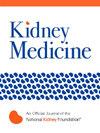2021年和2012年CKD-EPI eGFR方程与2009年CKD-EPI eGFR方程在中国人群中的比较
IF 3.4
Q1 UROLOGY & NEPHROLOGY
引用次数: 0
摘要
2024年KDIGO指南建议使用2021年慢性肾脏疾病流行病学合作(CKD-EPI)公式。我们使用最广泛应用的基于肌酐(eGFRcr)方程的2009年CKD-EPI估计肾小球滤过率作为参考,在中国大型临床人群中比较其他4种CKD-EPI eGFR方程。研究设计:横断面分析。背景和参与者:2017年7月1日至2023年7月1日在复旦大学中山医院进行肌酐(cr)和胱抑素C (cys)检测的临床接触者。暴露血清cr和血清cys。本研究比较了2012年CKD-EPI eGFRcr-cys和eGFRcys的临床效果,以及根据2009年CKD-EPI eGFRcr的2021年CKD-EPI eGFRcr和eGFRcr-cys在中国大量临床人群中的临床效果。分析方法根据性别、年龄、血清cys、血清cr水平及CKD分期对eGFR结果进行统计学评价。2009年CKD-EPI eGFRcr的总体结果中位数为74.9 mL/min/1.73m2。2012年CKD-EPI eGFRcys和eGFRcr-cys的中位数分别为67.6和72.2 mL/min/1.73m2。2021年CKD-EPI eGFRcr和eGFRcr-cys的中位数分别为79.5和75.0 mL/min/1.73 m2。与2009年CKD-EPI eGFRcr方程相比,2012年CKD-EPI eGFRcys方程差异最大。P30和P10分别为84.2%和39.5%。重新分类的程度为28.8%的参与者CKD阶段恶化,9.3%的参与者CKD阶段改善。与2009年CKD-EPI eGFRcr差异最小的是2021年CKD-EPI eGFRcr。P30为100.0%,P10为99.5%。重新分类的程度为14.3%的参与者CKD阶段改善。与2009年CKD-EPI eGFRcr方程相比,2012年和2021年CKD-EPI eGFRcr-cys方程之间的差异相似。测量GFR的限制。结论2021年和2009年CKD-EPI eGFRcr的结果似乎具有最好的可比性,而2012年CKD-EPI eGFRcr和2009年CKD-EPI eGFRcr的结果差异最明显。在判断患者CKD分期时应考虑eGFR方程之间的差异。肾小球滤过率(glomerular filtration rate, GFR)是评价肾功能的重要指标。由于GFR测量昂贵、耗时且有创,估计GFR被广泛用于肾功能评估。然而,不同eGFR方程的结果之间存在显著差异。2024年KDIGO指南建议使用2021年慢性肾脏疾病流行病学合作(CKD-EPI)公式。我们使用最广泛应用的2009年估计GFR肌酐(eGFRcr)方程作为参考,在中国大量临床人群中比较其他4种CKD-EPI eGFR方程。2021年和2009年CKD-EPI的eGFRcr结果具有最佳的可比性,而2012年CKD-EPI估计的GFR胱抑素C (eGFRcys)和2009年CKD-EPI的eGFRcr方程之间存在最大的差异。在判断患者CKD分期时应考虑eGFR方程之间的差异。本文章由计算机程序翻译,如有差异,请以英文原文为准。
Comparison of the 2021 and 2012 CKD-EPI eGFR Equations With the 2009 CKD-EPI eGFR Equation in a Chinese Population
Rationale & Objective
The 2024 KDIGO guideline recommends the use of the 2021 Chronic Kidney Disease Epidemiology Collaboration (CKD-EPI) equation. We used the most widely applied 2009 CKD-EPI estimated glomerular filtration rate based on creatinine (eGFRcr) equation as a reference to compare the other 4 CKD-EPI eGFR equations in a large clinical population in China.
Study Design
A cross-sectional analysis.
Setting & Participants
Individuals with clinical encounters at Zhongshan Hospital, Fudan University, from July 1, 2017, to July 1, 2023, who had both creatinine (cr) and cystatin C (cys) tested.
Exposures
Serum cr and serum cys.
Outcomes
This study compared the clinical effects of the 2012 CKD-EPI eGFR cr-cys and eGFRcys, 2021 CKD-EPI eGFRcr and eGFRcr-cys according to the 2009 CKD-EPI eGFRcr in a large clinical population in China.
Analytical Approach
The eGFR results were statistically evaluated according to sex, age, serum cys, and serum cr levels, and CKD stage.
Results
The 2009 CKD-EPI eGFRcr had the overall result with a median of 74.9 mL/min/1.73m2. The median of 2012 CKD-EPI eGFRcys and eGFRcr-cys were 67.6 and 72.2 mL/min/1.73m2, respectively. The median of 2021 CKD-EPI eGFRcr and eGFRcr-cys were 79.5 and 75.0 mL/min/1.73 m2, respectively. Compared with the 2009 CKD-EPI eGFRcr equation, the 2012 CKD-EPI eGFRcys equation had the greatest disagreement. The P30 and P10 were 84.2% and 39.5%, respectively. The extent of reclassification was 28.8% of participants had CKD stage worsening and 9.3% of participants had CKD stage improvement. The smallest difference with the 2009 CKD-EPI eGFRcr was observed in the 2021 CKD-EPI eGFRcr. The P30 was 100.0% and P10 was 99.5%. The extent of reclassification was 14.3% of participants had CKD stage improvement. The differences were similar between 2012 and 2021 CKD-EPI eGFRcr-cys equations when compared with the 2009 CKD-EPI eGFRcr equation.
Limitations
Lack of measured GFR.
Conclusions
The 2021 and the 2009 CKD-EPI eGFRcr results appeared to have the best comparability, whereas the results of the 2012 CKD-EPI eGFRcys and the 2009 CKD-EPI eGFRcr showed the most obvious difference. The differences between eGFR equations should be considered when judging the CKD stage of patients.
Plain-Language Summary
Glomerular filtration rate (GFR) is an important criterion for the assessment of kidney function. Because GFR measurement is expensive, time-consuming, and invasive, estimated GFR is widely used for kidney function assessment. However, there are significant discrepancies between the results of different eGFR equations. The 2024 KDIGO guideline recommends the use of the 2021 Chronic Kidney Disease Epidemiology Collaboration (CKD-EPI) equation. We used the most widely applied 2009 estimated GFR creatinine (eGFRcr) equation as a reference to compare the other 4 CKD-EPI eGFR equations in a large clinical population in China. The 2021 and the 2009 CKD-EPI eGFRcr results appeared best comparability, whereas the 2012 CKD-EPI estimated GFR cystatin C (eGFRcys) and the 2009 CKD-EPI eGFRcr equations had the greatest disagreement with each other. The differences between eGFR equations should be considered when judging the CKD stage of patients.
求助全文
通过发布文献求助,成功后即可免费获取论文全文。
去求助

 求助内容:
求助内容: 应助结果提醒方式:
应助结果提醒方式:


